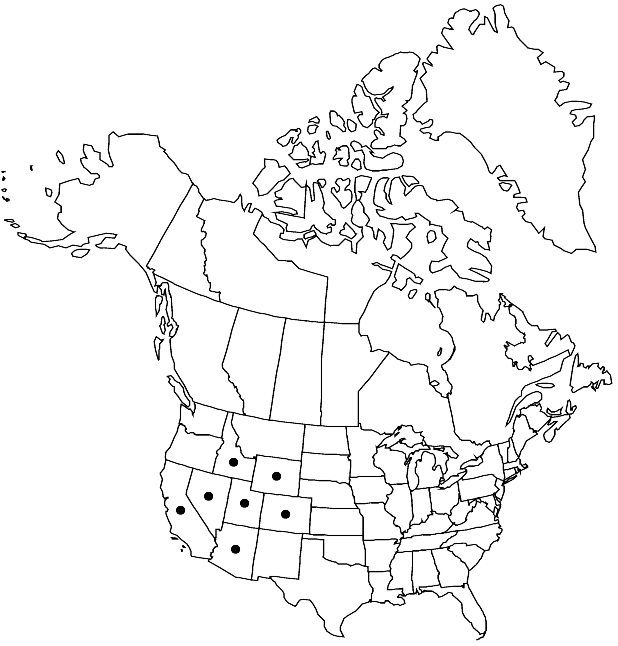Difference between revisions of "Caulanthus crassicaulis"
Botany (Fortieth Parallel), 27. 1871.
FNA>Volume Importer |
FNA>Volume Importer |
||
| Line 14: | Line 14: | ||
|name=Caulanthus crassicaulis var. glaber | |name=Caulanthus crassicaulis var. glaber | ||
|authority=M. E. Jones | |authority=M. E. Jones | ||
| − | }}{{Treatment/ID/Synonym | + | }} {{Treatment/ID/Synonym |
|name=Caulanthus glaber | |name=Caulanthus glaber | ||
|authority=A. Heller | |authority=A. Heller | ||
| − | }}{{Treatment/ID/Synonym | + | }} {{Treatment/ID/Synonym |
|name=Caulanthus senilis | |name=Caulanthus senilis | ||
|authority=unknown | |authority=unknown | ||
| Line 35: | Line 35: | ||
|elevation=1200-2900 m | |elevation=1200-2900 m | ||
|distribution=Ariz.;Calif.;Colo.;Idaho;Nev.;Utah;Wyo. | |distribution=Ariz.;Calif.;Colo.;Idaho;Nev.;Utah;Wyo. | ||
| − | |discussion=<p>E. B. Payson (1923), R. C. Rollins (1993), and R. E. Buck (1995) recognized two varieties of Caulanthus crassicaulis and separated them solely on the basis of var. crassicaulis having pubescent sepals and glabrous or pubescent leaves, and var. glaber having glabrous or sparsely pubescent sepals and glabrous leaves. In my opinion, this distinction is impractical; as in some other species of Caulanthus, both glabrous and pubescent forms occur sometimes within the same population.</p> | + | |discussion=<p>E. B. Payson (1923), R. C. Rollins (1993), and R. E. Buck (1995) recognized two varieties of <i>Caulanthus crassicaulis</i> and separated them solely on the basis of var. crassicaulis having pubescent sepals and glabrous or pubescent leaves, and <i></i>var.<i> glaber</i> having glabrous or sparsely pubescent sepals and glabrous leaves. In my opinion, this distinction is impractical; as in some other species of <i>Caulanthus</i>, both glabrous and pubescent forms occur sometimes within the same population.</p> |
|tables= | |tables= | ||
|references= | |references= | ||
| Line 59: | Line 59: | ||
|publication year=1871 | |publication year=1871 | ||
|special status= | |special status= | ||
| − | |source xml=https://jpend@bitbucket.org/aafc-mbb/fna-data-curation.git/src/ | + | |source xml=https://jpend@bitbucket.org/aafc-mbb/fna-data-curation.git/src/8f726806613d60c220dc4493de13607dd3150896/coarse_grained_fna_xml/V7/V7_1168.xml |
|tribe=Brassicaceae tribe Thelypodieae | |tribe=Brassicaceae tribe Thelypodieae | ||
|genus=Caulanthus | |genus=Caulanthus | ||
Revision as of 17:54, 18 September 2019
Perennials; glabrous or sparsely pubescent. Stems erect or ascending, usually unbranched, rarely branched, (hollow, strongly inflated, fusiform, to 3 cm diam. at widest point), 2–10 dm. Basal leaves rosulate; petiole 0.5–9 cm; blade obovate to oblanceolate (in outline), 1–12 cm × 3–45 mm, margins entire, dentate-sinuate, lyrate, runcinate, or pinnatifid. Cauline leaves (distalmost) shortly petiolate; blade linear to narrowly oblanceolate, margins entire. Racemes (densely flowered), with a terminal cluster of sterile flowers. Fruiting pedicels ascending, 1–5 mm, glabrous or pubescent, (trichomes flattened). Flowers: sepals erect (creamy white, purplish, or greenish), ovate to lanceolate, 7.5–14 × 2.5–4 mm (equal); petals brown or purple, 10–15 mm, blade 3–5 × 1.2–2.5 mm, not or hardly crisped, claw oblanceolate, 7–10 × 2–2.5 mm; filaments tetradynamous, median pairs 3–8 mm, lateral pair 2–7 mm; anthers narrowly oblong, equal, 3–6.5 mm. Fruits erect to ascending, terete or slightly latiseptate, 4.5–14 cm × 2–2.5 mm; valves each with obscure midvein; ovules 98–126 per ovary; style obsolete or, rarely, to 0.6 mm; stigma strongly 2-lobed (lobes to 1 mm, connivent, opposite valves). Seeds 1.5–4 × 1.5–2 mm. 2n = 28.
Phenology: Flowering Apr–Jul.
Habitat: Sagebrush scrub, pinyon-juniper woodland
Elevation: 1200-2900 m
Distribution

Ariz., Calif., Colo., Idaho, Nev., Utah, Wyo.
Discussion
E. B. Payson (1923), R. C. Rollins (1993), and R. E. Buck (1995) recognized two varieties of Caulanthus crassicaulis and separated them solely on the basis of var. crassicaulis having pubescent sepals and glabrous or pubescent leaves, and var. glaber having glabrous or sparsely pubescent sepals and glabrous leaves. In my opinion, this distinction is impractical; as in some other species of Caulanthus, both glabrous and pubescent forms occur sometimes within the same population.
Selected References
None.